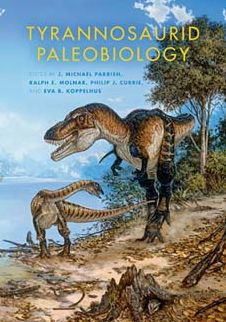Table of Contents
Introduction /J. Michael Parrish and Ralph E. MolnarPart One. Systematics and Descriptions1. Phylogenetic Revision of Chingkankousaurus fragilis, a Forgotten Tyrannosauroid from the Late Cretaceous of China /Stephen L. Brusatte, David W. E. Hone, and Xu Xing2. The Case for Nanotyrannus /Peter Larson3. Preliminary Analysis of a Sub-Adult Tyrannosaurid Skeleton from the Judith River Formation of Petroleum County, Montana /Walter W. Stein and Michael TrieboldPart Two. Functional Morphology and Reconstruction4. Internal Structure of Tooth Serrations /William L. Abler5. Feet of the Fierce (and Not So Fierce): Pedal Proportions in Large Theropods, Other Non-Avian Dinosaurs, and Large Ground Birds /James O. Farlow, Thomas R. Holtz, Jr., Trevor H. Worthy, and Ralph E. Chapman6. Relative Size of Brain and Cerebrum in Tyrannosaurid Dinosaurs: An Analysis Using Brain-Endocast Quantitative Relationships in Extant Alligators /Grant R. Hurlburt, Ryan C. Ridgley, and Lawrence M. Witmer7. Jane, In the Flesh: The State of Life-Reconstruction in Paleoart /Tyler Keillor8. Comparison of Reconstructed Jaw Musculature and Mechanics of Some Large Theropods /Ralph E. Molnar9. Tyrannosaurid Craniocervical Mobility: A Preliminary Assessment /Tanya SammanPart Three. Paleopathology, Paleoecology, and Taphonomy10. Clawing Their Way to the Top: Tyrannosaurid Pathology and Lifestyle /Bruce M. Rothschild11. Brodie Abscess Involving a Tyrannosaur Phalanx: Imaging and Implications /Christopher P. Vittore, MD and Michael D. Henderson12. Using Pollen, Leaves, and Paleomagnetism to Date a Juvenile Tyrannosaurid in Upper Cretaceous Rock /William F. Harrison, Douglas J. Nichols, Michael D. Henderson, and Reed P. Scherer13. The Biomechanics of a Plausible Hunting Strategy for Tyrannosaurus rex /David A. Krauss and James M. Robinson14. A Closer Look at the Hypothesis of Scavenging vs. Predation by Tyrannosaurus rex /Kenneth Carpenter15. New Evidence of Predation by a Large Tyrannosaurid /Nate L. Murphy, Kenneth Carpenter, and David Trexler Index



